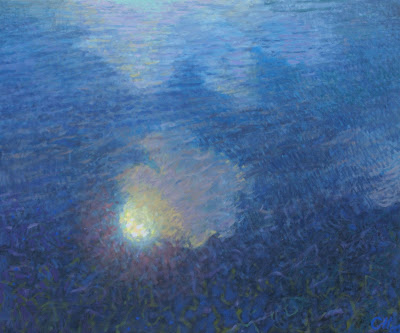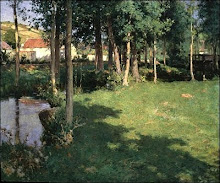Sunday, December 9, 2012
Edward Steichen
Best known for his iconic photographs, Edward Steichen also experimented with landscape painting. He destroyed many of his canvases, and these tonalist nocturnes are are some of the surviving works.
Steichen used delicate washes of thinned oil colour, one over another, to create an opalescent effect and a mood of poetic reverie reminiscent of Whistler and George Innes.
This effect does not come across well in reproductions.
Steichen was born in Luxembourg and immigrated to the US as an infant in 1881. He died in 1973 at the ripe old age of 93.
Friday, November 30, 2012
Rivers
Corot, Le Ruisseau au Cheval Blanc, 46.9 x 72.3 cm.
Henri Biva, By the River.
Levitan.
Munnings.
Jorge Cerda Girones.
Thursday, November 1, 2012
Caspar David Friedrich, Quotes
After a long period during which his work was neglected and misunderstood (it was even associated with Nazism at one stage) Caspar Friedrich is now appreciated as a major figure in landscape painting, and perhaps the most important German painter of the Romantic period. His landscapes are unique, not only because they draw from a deep contemplation of Nature but because they reflect an inner world of eternal values.
Friedrich wrote a collection of aphorisms communicating his insights into painting. Here are some of them:
"Close your bodily eye, that you may see your picture first with the eye of the spirit. Then bring to light what you have seen in the darkness, that its effect may work back, from without to within."
"If he sees nothing within, then he should stop painting what is in front of him."
The painter should paint not only what he has in front of him, but also what he sees inside himself.
"What the newer landscape artists see in a circle of a hundred degrees in Nature they press together unmercifully into an angle of vision of only forty-five degrees. And furthermore, what is in Nature separated by large spaces, is compressed into a cramped space and overfills and oversatiates the eye, creating an unfavorable and disquieting effect on the viewer."
"The pure, frank sentiments we hold in our hearts are the only truthful sources of art. A painting which does not take its inspiration from the heart is nothing more than futile juggling. All authentic art is conceived at a sacred moment and nourished in a blessed hour; an inner impulse creates it, often without the artist being aware of it."
The Russian writer Aleksandr Turgenev wrote of Friedrich in his diary:
We visited Friedrich's atelier today. Listening to him and seeing his paintings was wonderful. He has some bonhomie which pleases people and his paintings reveal his romantic imagination. As a rule, he expresses in them one thought or feeling, though vaguely. You may meditate over his paintings but not have a clear understanding of them, for they are vague even in his soul. They are dreams or daydreams. He often employs very simple natural things, such as an ice block floating on sea waves, a few trees in a dale, window of his room (facing the beautiful Elbe), knight meditating over ruins or tombstones, monk staring into the distance or below his feet: all this captivates your soul, plunges you into dreams, all invokes your imagination, powerfully though vaguely.(6 August 1825)
The Russian writer Aleksandr Turgenev wrote of Friedrich in his diary:
We visited Friedrich's atelier today. Listening to him and seeing his paintings was wonderful. He has some bonhomie which pleases people and his paintings reveal his romantic imagination. As a rule, he expresses in them one thought or feeling, though vaguely. You may meditate over his paintings but not have a clear understanding of them, for they are vague even in his soul. They are dreams or daydreams. He often employs very simple natural things, such as an ice block floating on sea waves, a few trees in a dale, window of his room (facing the beautiful Elbe), knight meditating over ruins or tombstones, monk staring into the distance or below his feet: all this captivates your soul, plunges you into dreams, all invokes your imagination, powerfully though vaguely.(6 August 1825)
Wednesday, October 3, 2012
Steps
Frederic Leighton, The Staircase of a House at Capri, 1859.
Henri Le Sidaner, Steps of the Palace at Versailles (Les Marches du Palais)
John Singer Sargent:
Santa Maria della Salute, 1906
The Steps of the Church of S. S. Domenico-e-Siste in Rome
Staircase in Capri, 1878
Friday, September 7, 2012
The Cloud Study
Cloud study, Anonymous.
Views of clouds reflected in water are an interesting variation, popularised of course by Monet.
The cloud study is a great plein air exercise. It's something you can do anywhere, even in the city, or in a landscape where the scenery at ground level is totally uninspiring.
And because clouds are a moving target, it forces you to paint rapidly. Having a palette prepared with tonal strings of blues and greys would be a good idea, so that you don't waste time mixing. Adding a speck of yellow to the whites and violet to the grey shadows produces a nice complementary colour harmony.
Johan Dahl, Cloud study (Wolkenstudie)
Views of clouds reflected in water are an interesting variation, popularised of course by Monet.
Here's one by the Western Australian artist George Haynes.
Tuesday, August 21, 2012
Using Encaustic to Create Texture
Last night I watched a TV documentary about the life and work of the Australian artist Jenny Sages.
It was inspiring to learn that someone, who only took up a serious art career in her early 50s, went on to win many major awards in her chosen areas of landscape and portraiture.
The catalyst for her decision to take up fine art, full time, was a painting expedition to a remote area of the Australian outback. She said it was an epiphany for her; the landscape totally changing her palette and approach to making art. Her conversion was sudden and complete.
I've had a similar experience in central Australia - the colours there are indescribable opalescent pinks and greys. The desert regions, tend to lack the conventional elements of landscape subjects: trees, mountains and lakes, and lend themselves to abstraction.
Wanting to convey the complex textures of this ancient worn landscape, Sages took up the medium of encaustic (wax mixed with pigment). The melted wax is poured onto a board and spread over the surface, immediately creating interesting random textures and a kind of sculptural element. Sages then engraved the wax, gouging and scratching it with a variety of sharp implements, further adding to the texture. She then rubbed powdered pigment into the surface.
Though I have never used it myself, I have read that encaustic is compatible with the oil medium, and a great way to introduce texture into a landscape painting, whether it be representational or abstract.
Thursday, August 16, 2012
Massing for Impact
Top: Fannie Eliza Duval.
Middle: Unknown (Russian?).
Bottom: Gustave Caillebotte, Roses in the Garden at Petit Gennevilliers, 1886.
For maximum visual impact landscape gardeners often make mass plantings of the same flower.
This applies to paintings too.
Tuesday, July 24, 2012
Cattle
Constant Troyon, Toques River, Normandy.
This work was greatly admired, in its day, for its evocation of light. It seems to have been a precursor of the Impressionist fascination with light and atmosphere.
Middle Image: Polder Landscape with Group of Five Cows.
In this early Piet Mondrian you can already see the simplification and repetition of forms that later developed into pure abstraction.
The last piece is by Cotman. A little gem of a painting. Cotman was a watercolourist but this piece is quite opaque in parts and may be gouache or oil.
Sunday, June 24, 2012
Edgar Payne
Edgar Payne's book "Composition of Outdoor Painting" is often recommended by landscape artists. It may be out of print, but there are often copies to be found online. There are some for sale at
www.amazon.com (A new copy is very expensive).
www.amazon.com (A new copy is very expensive).
In the book, Payne categorises various types of composition to help the reader design their paintings rather than simply capturing random snapshots of the landscape.
These compositional types are not intended to be fixed recipes. The artist should adapt them to use in original ways.
Compositional design does not imply that one is 'fudging' reality, it is simply a means of knowing what to look for when deciding what to paint.
Monday, May 21, 2012
Summer
Claustro de Georges Sands
Garden of Sa Coma, Valdemosa
In these two landscapes the Spanish (Catalan) painter Santiago Rusinol (February 25, 1861 - 1931) uses daringly bright greens to evoke the intense light of the mediterranean summer.
Rusinol was particularly fond of painting gardens, and was a supporter of modernism, who influenced Picasso.
Tuesday, May 8, 2012
Philip Wolfhagen
Third Exaltation
The study of clouds was my first interest within the genre of landscape painting and every few years I return to the subject with renewed enthusiasm. Often I am driven by dissatisfaction with my earlier efforts, always striving for a more refined palette and a lighter touch.
The study of clouds was my first interest within the genre of landscape painting and every few years I return to the subject with renewed enthusiasm. Often I am driven by dissatisfaction with my earlier efforts, always striving for a more refined palette and a lighter touch.
Third exaltation is one of a series of five large cloud paintings from 2011. In this painting I have worked over a pale citrus yellow ground, concentrating on paring back tonality to its bare minimum and allowing colour temperature to define pictorial depth.
- Philip Wolfhagen, 2012
This large scale work (I think it's about 3 x 3 m) was a finalist in the Wynne Prize this year, perhaps the most prestigious landscape prize in Australia.
Using a warm orange or yellow ground lends vibrancy to the blues and greys in skies.
Friday, April 20, 2012
Trees
Alexander Helwig Wyant, American, 1836-1892, oil on canvas laid on board, Willows by a Lake, 10 x 11 inches.
Pal Szinyei-Merse, Hilly Landscape, 60.5 x 70 cm.
These compositions crop out most of the sky and background, to focus on trees and the pattern of their foliage.
It's a common mistake to try to capture too much of the scene. Zooming in to a few trees, or even a single tree, can often give you a more interesting and intimate painting.
Edwin Lord Weeks, Street Scene, Bombay
Sunday, March 18, 2012
American Modernism
Grant Wood, Spring in the Country, 1941.
James Everett Stuart, Mount Hood, 1916.
Rockwell Kent, Mt Assiniboine, 1952.
Muscular in design, and daring in color. These works of American modernism, can teach a lot about the value of simplifying what you see before you in the landscape, to paint the timeless spirit of a place rather than merely its specific physical appearance.
Monday, February 20, 2012
Norwegian scenes
Some Norwegian painters:
1. Fritz Thaulow
2. Johan Eckersberg
3. Hans Gude
The last image is by Peter Vilhelm Ilsted, who was Danish, but Norway and Denmark were a single kingdom at one stage.
Subscribe to:
Comments (Atom)













































.jpg)













+1900.bmp)